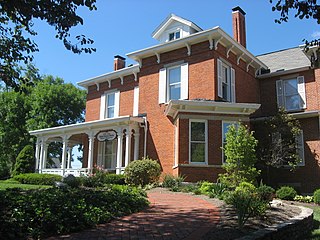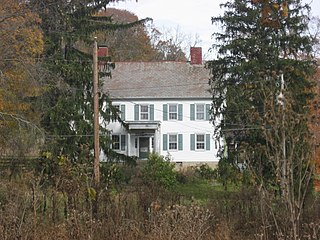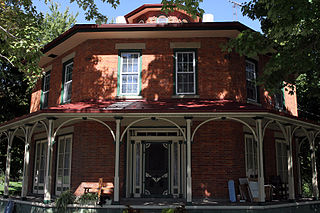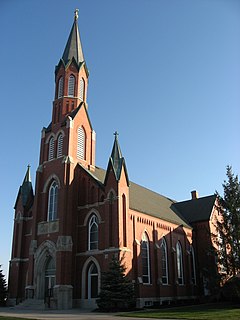
Clarence Seward Darrow was an American lawyer who became famous in the early 20th century for his involvement in the Leopold and Loeb murder trial and the Scopes "Monkey" Trial. He was a leading member of the American Civil Liberties Union, and a prominent advocate for Georgist economic reform.

Kinsman is an unincorporated community and census-designated place in southern Kinsman Township, Trumbull County, Ohio, United States. Its population was 616 as of the 2010 census. Although it is unincorporated, it has a post office, with the ZIP code of 44428; as well as a library, the Kinsman Free Public Library. It lies along State Route 7 between Williamsfield and Burghill, at the intersection with State Route 5.

The Morrison House is a historic residence in Cincinnati, Ohio, United States. One of the area's first houses designed by master architect Samuel Hannaford, the elaborate brick house was home to the owner of a prominent food-processing firm, and it has been named a historic site.

The Louis Sawyer House is a historic residence in the city of Wyoming, Ohio, United States. Erected at the turn of the twentieth century, it was originally the home of an important lawyer, and it has been designated a historic site because of its architecture.

The Winton Place Methodist Episcopal Church is a historic church building in the Winton Place neighborhood of Cincinnati, Ohio, United States that was constructed as the home of a congregation of the Methodist Episcopal Church in the late nineteenth century. The congregation grew out of a group that was founded in 1856; although the members erected their first building in 1860, they were not officially organized until 1872. Among the leading members of the congregation was Samuel Hannaford, a prominent Cincinnati architect. When the congregation chose to build a new church building in 1884, Hannaford was chosen as the architect for the project. At this time, Hannaford was near to the peak of his prestige: he had ended a partnership with another architect seven years before, and his reputation was growing with his designs of significant Cincinnati-area buildings such as the Cincinnati Music Hall.

The Henry P. Deuscher House is a historic farmhouse in the countryside of the southwestern part of the U.S. state of Ohio. Located near the city of Trenton, it was originally home to one of the area's leading farmers, and it has been named a historic site.

The Henry Maltby House was a historic house near the campus of Miami University in Oxford, Ohio, United States. Built in the 1850s, it was once home to a prominent minister in the community. Important partly for its architecture, it was eventually relegated to student housing before being demolished. Before its destruction, it was named a historic site.

The Adams–Gray House is a historic farmhouse in the community of Adams Mills, Ohio. Constructed in the 1840s in two separate counties, it has been named a historic site.

Andalusia, also known as the Nicholas Biddle Estate, is a historic mansion and estate located on the Delaware River, just north of Philadelphia, in Bensalem Township, Bucks County, Pennsylvania. The community surrounding it, Andalusia, takes its name from the 225-acre estate.

The Rhea County Courthouse is a historic county courthouse in the center of Dayton, the county seat of Rhea County, Tennessee. Built in 1891, it is famous as the scene of the Scopes Trial of July 1925, in which teacher John T. Scopes faced charges for including Charles Darwin's theory of evolution in his public school lesson. The trial became a clash of titans between the lawyers William Jennings Bryan for the prosecution and Clarence Darrow for the defense, and epitomizes the tension between fundamentalism and modernism in a wide range of aspects of American society. The courthouse, now also housing a museum devoted to the trial, was designated a National Historic Landmark in 1976.

The Octagon is a historic octagon house on the campus of Heidelberg University in Tiffin, Ohio, United States. Built in the mid-19th century, it has been used for residential purposes throughout its history, and while it has experienced over a century of gradual deterioration, it has been named a historic site, and the 21st century has seen plans to restore it to its original integrity.

The John Hosford House is a historic octagon house located along U.S. Route 20 in Monroeville, Ohio, United States. Built at an unknown point in the mid-nineteenth century, it has been named a historic site.

The William Lawrence House is a historic house in Bellefontaine, Ohio, United States. Located along Main Street north of the city's downtown, it is historically significant as the home of William Lawrence, a prominent U.S. Representative during the late nineteenth century.

Mechanicsburg United Methodist Church is a historic Methodist congregation in the village of Mechanicsburg, Ohio, United States. Founded in the early nineteenth century, it is the oldest church in the village, and as such it has played a part in the histories of other Mechanicsburg churches. Its fifth and present church, a Gothic Revival-style structure erected in the 1890s, has been named a historic site.

St. Rose's Catholic Church is a historic Catholic church in St. Rose, an unincorporated community in Marion Township, Mercer County, Ohio, United States.

The Seip House is a historic building on the west side of Chillicothe, Ohio, United States. Built in 1895, it is among the city's grandest houses.

The Young-Shaw House was a historic farmhouse located near Sarahsville, Ohio, United States. A simple building originally home to a wealthy farmer, it was passed down through numerous generations of the original owner's family, and it has been named a historic site.

Thunderbird Lodge is a building of historical and architectural significance in the utopian community of Rose Valley, Delaware County, Pennsylvania.

The Martin Bushnell House is a historic residence in the city of Mansfield, Ohio, United States. Built in 1892, the house was home to Martin Bushnell, a prominent civic leader, businessman, and politician, and it has been named a historic site.

The Holmes County Courthouse is a historic government building in Millersburg, Ohio, United States. Built in the late nineteenth century, it has been designated a historic site because of its architectural importance.






















